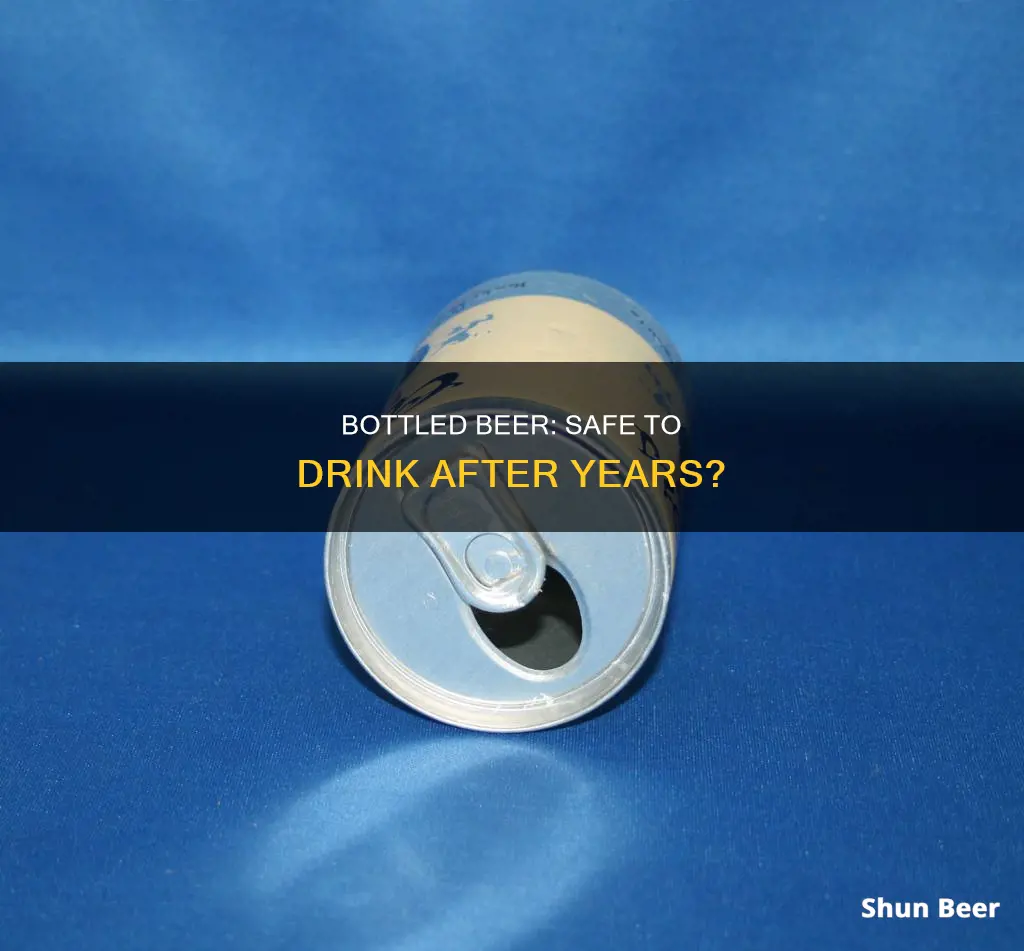
Beer is a type of alcohol that can go bad. However, it does not become unsafe to drink, even long after its best before date. The main issue with old beer is that its flavour will degrade over time. Beer stales when exposed to light, oxygen, and heat, which break down the organic compounds that make beer smell and taste great. This results in a flat, flavourless, and unappealing drink.
| Characteristics | Values |
|---|---|
| Is old bottled beer safe to drink? | Yes, old bottled beer is safe to drink as no harmful pathogens will grow in it once it's fully fermented. |
| How does beer taste after it's expired? | The flavour of the beer will degrade over time. It will taste flat, flavourless, and unappealing. |
| How long does beer last? | Beer lasts for about 6-9 months beyond the dates on the label. If refrigerated, it can last up to 2 years beyond the expiration date. |
| How to tell if the beer has gone bad? | You will hear a "psssst" sound when you open the bottle. Lack of foam is another indication that the beer has gone bad. |
| How to store beer? | Beer should always be stored upright in a cool, dark place. |
What You'll Learn

Beer is safe to drink after its 'best before' date
Beer is generally safe to drink after its best-before date, but its flavour and quality will degrade over time. Beer is a perishable product that stales when exposed to light, oxygen and heat, which break down the organic compounds that give beer its flavour and taste. However, even when its flavour is declining, it can be safe to drink.
Most beer is either pasteurised or filtered to eliminate bacteria, making it extremely resistant to spoiling. There are no harmful pathogens in fully fermented beer, so it is safe to drink even after the best-before date. However, the beer may not taste very good. Over time, beer will oxidise, and the oxygen causes the beer to stale, producing tones of sherry, paper and cardboard. Hop aromas are muted, and other forms of staling can lead to a soapy taste.
The speed of these reactions depends on the alcohol content of the beer and how it is stored. Beers with more alcohol by volume have a longer shelf life. Refrigerating beer slows the process of ageing, so it is best to store beer in the fridge. Beers stored at a stable temperature and out of the light will be good for about a year before starting to turn.
Some beers, like wine and whiskey, can improve with age. Richer and higher ABV varieties such as porters and stouts can get better with age, especially if kept in cool, dark storage. However, IPAs, especially hoppy ones, gradually lose their flavour and aroma and are best drunk fresh.
Drinking 10 Beers Daily: A Recipe for Disaster
You may want to see also

Beer's flavour degrades over time
Beer flavour degrades over time due to several factors, including oxidation, heat, and exposure to light. Here are some key points to consider:
- Beer is susceptible to flavour degradation due to its organic compounds reacting with oxygen, a process known as oxidation. This results in stale-tasting beer with tones of sherry, paper, and cardboard. Hop aromas are muted, and bitterness may become more pronounced.
- The speed of flavour degradation is influenced by the alcohol content of the beer and how it is stored. Beers with higher alcohol content generally have a longer shelf life. Refrigeration also slows down the degradation process, so it is recommended to store beer in a cool, dark place.
- Beer flavour can also be affected by heat. Higher temperatures accelerate the degradation process, shortening the beer's shelf life. For example, a typical domestic lager stored at room temperature (75°F) is expected to stay fresh for up to 17 weeks.
- Exposure to light can cause a "skunky" flavour in beer. Clear and green bottles are more susceptible to this issue, while brown glass, cans, and kegs block the wavelengths that cause this off-flavour.
- The type of beer also plays a role in flavour degradation. Pale and dry-hopped beers are generally more susceptible to flavour changes than dark or heavily kettle-hopped beers.
- Flavour degradation can also be influenced by the presence of certain chemicals, such as aldehydes, lipids, and sulfur compounds. Small fluctuations in fermentation by-products can lead to a concentration of these chemicals, resulting in off-flavours.
- Overall, while beer may remain safe to consume even after its expiration date, its flavour will gradually deteriorate over time due to various factors. Proper storage conditions, such as refrigeration and protection from light, can help slow down this process.
The Beer Choice of Misato: A Deep Dive
You may want to see also

Beer is perishable and stales when exposed to light, oxygen and heat
Beer is a perishable product and is best consumed fresh. It is susceptible to staling when exposed to light, oxygen, and heat, which degrade the organic compounds that make beer smell and taste great.
When exposed to light, the flavour of beer can be drastically altered. In lighter-coloured beers, flavours of honey, wax, paper, and even wet cardboard can emerge. Meanwhile, darker beers can take on sherry-like flavours or other oxidised characteristics that mask their original taste.
Oxygen also plays a role in the staling process. Over time, the aroma and flavour compounds found in hops oxidise and dissipate, resulting in a loss of the bright hop aroma and bitterness typically found in fresh beer. Conversely, certain aromatic compounds can increase, leading to sweet and malty flavours.
Heat accelerates the staling process. The Miller Brewing Company established the 3-30-300 rule to illustrate this point: their product stored at refrigerator temperature for 300 days tasted just as fresh as the same beer kept at room temperature (68°F or 20°C) for only 30 days.
While old beer may be safe to drink, its flavour will degrade over time. The speed of this process depends on the alcohol content of the beer and how it is stored. Beers with higher alcohol content tend to have a longer shelf life. Refrigerating beer slows down the staling process, so it is recommended to store beer in a cool, dark place and consume it within three to six months of packaging or before its best-by date.
Drinking Beer on the Sidewalk: What's the Legal Stand?
You may want to see also

Beer doesn't expire, but it does go flat and taste bad
Beer is a perishable product that can be safely consumed past its expiration date, but its flavour will degrade over time. It is important to note that beer doesn't actually spoil or become unsafe to drink, but it will start to taste flat, flavourless, and unappealing.
Beer stales when exposed to light, oxygen, and heat, which break down the organic compounds that make beer smell and taste great. The higher the alcohol content of the beer, the less concerned you need to be with its use-by date. Beers with more alcohol by volume have a longer shelf life.
The speed of the ageing process depends on the alcohol content of the beer and how it is stored. Refrigerating beer slows down the process of ageing, so always opt for beer that is in the cooler, not on the shelf. Beer stored in a refrigerator can last up to two or three years unopened, but an opened bottle or can will only be good for a day before oxidation destroys all the good flavours.
To enjoy beer at its best, buy it cold, store it in the fridge, and consume it within three to six months of packaging or before the best-by date.
Pumping and Drinking: Beer's Effect on Breast Milk
You may want to see also

Beer should be stored upright, in a dark place, at a constant temperature
Beer is a perishable product that can be sensitive to its environment. It can be stored and remain safe to drink for years, but its flavour will degrade over time. Beer is susceptible to staling when exposed to light, oxygen, and heat, which break down the organic compounds that make beer smell and taste great.
The best way to store beer is upright, in a dark place, at a constant temperature. Beer should be stored upright as this minimises the beer's contact with air. Beer that is stored on its side is prone to air leaks, which can cause the beer to go flat. Keeping beer in a dark place is also important as exposure to sunlight can cause a chemical reaction in the beer, breaking down its flavour components until it smells and tastes like skunk spray. This process is known as "skunking" or the beer becoming "lightstruck".
The optimal temperature for storing beer is between 45 and 55 degrees Fahrenheit (approximately 7 to 13 degrees Celsius). Beer stored at this temperature will remain at its peak of freshness and flavour. Beer stored at room temperature will decline in quality more quickly. Beer that gets too hot will accelerate the aging process and deplete its nutrients. Beer that is too cold will taste flat.
If you are storing beer long-term, it is best to contact the brewery for advice. However, as a general rule, beer should be stored in a cool, dark place, with its container kept upright, and the temperature kept constant.
Mixing Beer and Cough Syrup: What You Should Know
You may want to see also
Frequently asked questions
Yes, old bottled beer is safe to drink. Beer is a type of alcohol that is either pasteurized or filtered to eliminate bacteria, making it extremely resistant to spoiling. However, the beer's flavour will degrade over time.
Bottled beer lasts for about 6-9 months beyond the dates on the label. Beer is best consumed within three to six months of packaging, or before its best-by date.
Before opening the bottle, check for clues such as a dusty bottle, a discoloured label, or seepage around the cap. After opening the bottle, if you don't hear the normal "psssst" sound or see white foam rising from the liquid, your beer has likely gone bad.
The flavour of expired beer becomes flat, malty, sweet, and less bitter.







